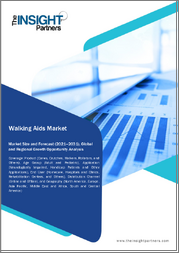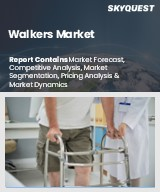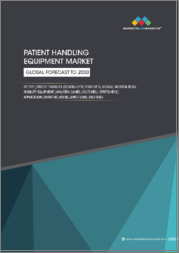
|
시장보고서
상품코드
1495951
보행 보조 기기 시장 - 예측(2024-2029년)Assisted Walking Devices Market - Forecasts from 2024 to 2029 |
||||||
보행 보조 기기 시장은 2022년 38억 2,800만 달러에서 2029년 58억 1,900만 달러로 연평균 6.17% 성장할 것으로 예상됩니다.
보행 보조기구는 거동이 불편한 사람들에게 지지와 지원을 제공하여 보다 쉽고 안전하게 걸을 수 있도록 설계된 도구입니다. 이러한 기구는 노화와 관련된 문제, 부상, 장애 또는 질병으로 인해 보행에 어려움을 겪는 사람들이 자주 사용합니다.
노인 인구의 증가와 함께 이동 장애의 유병률 증가는 더 많은 이동 문제를 야기하고 있으며, 이는 보행 보조 기기 시장의 주요 성장 요인으로 작용하고 있습니다. 또한, 기술 발전과 재활 장비에 대한 수요 증가는 시장 확대를 더욱 가속화하고 있습니다.
시장 촉진요인:
- 이동 장애 발생률의 증가는 시장 성장에 기여하는 주요 요인 중 하나입니다.
질병, 부상, 사고 등으로 인한 장애의 확산은 보행 보조기구에 대한 수요 증가로 이어지고 있습니다. 관절염, 골다공증, 파킨슨병, 근골격계 질환은 전 세계적으로 증가하고 있으며, 이는 보행 보조기 시장을 견인할 것으로 예상됩니다.
예를 들어, 세계보건기구(WHO)에 따르면 2022년 6월에는 전 세계적으로 약 17억 1,000만 명이 근골격계 질환을 앓고 있을 것으로 예상됩니다. 또한, CDC에 따르면 관절염은 미국 성인들 사이에서 가장 흔한 취업 불능의 원인이며, 현재 약 2,570만 명이 관절염과 관련된 일상 활동의 제한을 경험하고 있으며, 이 숫자는 2040년까지 3,500만 명으로 증가할 것으로 예상됩니다.
- 인구 고령화도 시장 성장을 촉진할 것입니다.
세계 인구의 고령화에 따라 근력 저하, 관절 문제, 균형 문제 등 노화와 관련된 문제로 인한 이동 지원의 필요성이 증가하고 있습니다. 보행 보조기구는 노인의 자립과 이동성을 유지할 수 있는 솔루션을 제공함으로써 이러한 계층에 대응하고 있습니다.
Health Ageing Organization에 따르면, 노인이 직면하는 이동성 문제 중 1위는 낙상입니다. WHO에 따르면 2030년까지 전 세계 6명 중 1명이 60세 이상이 될 것이며, 2020년 10억 명에서 14억 명으로 증가할 것이며, 2050년에는 이 연령층이 21억 명으로 두 배로 늘어날 것이라고 합니다.
- 재활 장비에 대한 수요 증가가 시장을 주도하고 있습니다.
수술, 부상, 의료 시술에서 회복된 사람들은 종종 재활의 일환으로 보행 보조기구가 필요하며, WHO에 따르면 1,300만 명의 류마티스 관절염 환자가 중등도 또는 중증 질환을 앓고 있어 재활의 혜택을 받을 수 있다고 합니다. 교통사고로 인해 심각한 부상을 입은 사람들은 재활을 위해 이동 보조기구가 필요한 경우가 많습니다. 따라서 교통사고가 많이 발생하면 보행 보조 기기 시장이 가속화될 것으로 예상됩니다. 예를 들어, WHO에 따르면 치명적이지 않은 부상은 2,000만 명에서 5,000만 명 이상의 개인에게 영향을 미치며, 그 중 상당수는 부상으로 인해 장애인이 됩니다.
- 기술의 발전은 시장의 추가 성장을 촉진할 것입니다.
기술 혁신으로 전동식 외골격, 스마트 보조기 솔루션 등 더욱 정교한 보행 보조기구가 개발되고 있습니다. 이러한 기술들은 중증 운동 장애를 가진 사람들에게 보다 향상된 이동 옵션을 제공합니다.
스마트 보조기는 센서와 액추에이터를 통합하여 실시간 피드백을 제공하고 사용자의 움직임에 따라 지지대를 조정하여 보행 패턴과 균형을 최적화합니다. 예를 들어, CAN Mobilities는 2022년 6월 데이터를 통해 이동성을 향상시키기 위해 세계에서 가장 스마트한 보행 지팡이인 CAN Go를 개발했는데, CAN Go는 항공기 등급의 알루미늄으로 제작된 매우 편안하고 내구성이 뛰어나며 세련된 지팡이로, 안전성을 높이기 위해 부드럽고 끈적거리지 않으며 미끄럼 방지 그립이 있어 안전성을 높였습니다.
시장 억제요인:
보행 보조 기기 시장은 성장과 개척을 경험하고 있지만, 시장 억제요인과 과제가 시장 확대에 영향을 미칠 수 있습니다. 예를 들어, 일부 첨단 기술 및 전동 장치는 고가이기 때문에 소득 수준이 낮은 개인이나 의료 자원이 제한된 지역에서는 접근성이 제한될 수 있습니다.
예를 들어, 접이식 휠체어는 일반적으로 9,000 인도 루피 이상이기 때문에 경제적으로 불균등하게 분포된 지역에서는 접근하기 어려울 수 있습니다. 또한, 전동 장비와 첨단 기술에는 정기적인 유지보수와 수리가 필요하며, 이는 시간이 오래 걸리고 사용자에게 추가 비용이 발생합니다.
북미는 큰 폭의 성장이 예상
예측 기간 동안 북미가 보행 보조 기기 시장에서 큰 비중을 차지할 것으로 예상됩니다. 이러한 점유율의 요인으로는 높은 이동 장애 유병률, 고령 인구, 기술 개발, 정부 지원 등을 들 수 있습니다. 예를 들어, CDC 데이터에 따르면 미국 인구의 약 12.1%가 보행 및 계단 오르기 문제로 이어지는 심각한 운동 장애를 앓고 있으며, Drive DeVilbis와 같은 시장 리더의 존재는 시장 확장을 더욱 촉진할 것입니다.
주요 시장 진입 기업
- Honda Global은 자동차 및 동력 장치 제조를 전문으로 하는 일본 기업이며, American Honda Motor Co., Inc.는 2009년에 처음으로 보행 보조기구의 프로토타입을 발표했습니다. 첫 번째 장치인 Stride Management Assist는 노인과 다리 근육이 약한 사람들의 보행을 돕기 위해 고안되었습니다.
- Drive DeVilbiss Healthcare는 다양한 수준의 거동이 불편한 사람들의 삶을 개선하기 위해 이동 보조기구 및 보행 보조기구를 포함한 다양한 의료 의료 의료 제품을 제공하는 전문 기업입니다. IC Crunch Hand Grips, Respiratory Rollator Accessory Pack 등을 제공하고 있습니다.
- Elderluxe는 시니어와 노인을 위한 고급 제품과 솔루션을 제공하는 전문 기업입니다. 다양한 보행 지팡이, 이동용 스쿠터, 보행기, 롤러를 제공하고 있습니다. 대표적인 제품으로는 GT-80 파워 탄소섬유 지팡이(더비 핸들 포함), 트리오닉 벨로페드 스포츠 12er, 14er 등이 있습니다.
주요 시장 개척:
- 2023년 3월, Toyota는 C pod*3에 이어 보행 보조차 시리즈 2탄인 C walk S를 출시했으며, C pod*3에 이어 C walk T*2를 개선했습니다.
- 2023년 5월, Complete Care Shop은 영국 최초의 손잡이가 달린 양손 지팡이 'Freestyle Grab and Go'를 출시했습니다. 이 지팡이에는 손잡이가 내장되어 있어 허리를 굽히지 않고도 작은 물건이나 자주 떨어뜨리는 물건을 집어들 수 있습니다.
- 2022년 4월, Getinge는 수술대용으로 설계된 새로운 시스템을 발표했습니다. 이 시스템은 한 다리를 고정하는 데 중점을 둡니다. 이 시스템은 두 종류의 무릎 목발에 대응할 수 있으며, 비용 절감, 수술 간격 단축, 환자 편의성 향상 등의 이점이 있습니다.
목차
제1장 소개
- 시장 개요
- 시장 정의
- 조사 범위
- 시장 세분화
- 통화
- 가정
- 기준 연도와 예측 연도 타임라인
- 이해관계자에 대한 주요 이점
제2장 조사 방법
- 조사 디자인
- 조사 과정
제3장 주요 요약
- 주요 조사 결과
- 애널리스트의 견해
제4장 시장 역학
- 시장 성장 촉진요인
- 시장 성장 억제요인
- Porter's Five Forces 분석
- 업계 밸류체인 분석
- 애널리스트의 견해
제5장 보행 보조 기기 시장 : 제품별
- 소개
- 지팡이
- 목발
- 워커
- 보행 훈련기
제6장 보행 보조 기기 시장 : 유통 채널별
- 소개
- 온라인
- 오프라인
제7장 보행 보조 기기 시장 : 최종사용자별
- 소개
- 병원
- 기타
제8장 보행 보조 기기 시장 : 지역별
- 소개
- 북미
- 남미
- 유럽
- 중동 및 아프리카
- 아시아태평양
제9장 경쟁 환경과 분석
- 주요 기업과 전략 분석
- 시장 점유율 분석
- 합병, 인수, 합의와 협업
- 경쟁 대시보드
제10장 기업 개요
- Honda Global
- Drive DeVilbiss
- Physio-pedia
- HME Home Health
- Elderluxe
- Homecare Medical
- ALIMCO
- ByACRE
- Millbrook Healthcare
- Arcatron
The assisted walking devices market is expected to grow at a CAGR of 6.17% from US$3.828 billion in 2022 to US$5.819 billion in 2029.
Assisted walking devices are tools designed to provide support and assistance to individuals with mobility challenges, helping them walk more easily and safely. These devices are often used by people who have difficulty walking due to age-related issues, injuries, disabilities, or medical conditions.
The rising prevalence of mobility disorders coupled with the growing elderly population leading to more mobility problems are a major growth driver of the assisted walking devices market. Moreover, technological advancements and increasing demand for rehabilitation equipment further accelerate market expansion.
Market Drivers:
- Rising Incidence of Mobility Disabilities are one of the major factors contributing to the growth of the market.
The prevalence of disabilities caused by medical conditions, injuries, and accidents has led to a growing demand for walking aids. There are increasing cases of arthritis, osteoporosis, Parkinson's disease, and musculoskeletal conditions worldwide which is expected to boost the assisted walking devices market.
For instance, according to the WHO, about 1.71 billion individuals worldwide were expected to have musculoskeletal problems in June 2022. Moreover, according to the CDC, arthritis is the most prevalent cause of job incapacity among US adults, with an estimated 25.7 million people currently experiencing arthritis-related limits in their daily activities, and that number is expected to rise to 35 million by 2040.
- Aging Population also pushes the market to grow.
As the global population ages, there is an increasing need for mobility assistance due to age-related issues, such as reduced muscle strength, joint problems, and balance challenges. Assisted walking devices cater to this demographic by providing solutions that enable older individuals to maintain their independence and mobility.
According to the Health Ageing Organization, the number one mobility issue that older persons face is falls. This results in broken bones, and bruises leading to a permanent need for assisted walking devices. According to the WHO, by 2030, 1 in 6 people globally will be 60 years or older, rising from 1 billion in 2020 to 1.4 billion. By 2050, this age group will double to 2.1 billion.
- Increasing Demand for Rehabilitation Equipment drives the market.
People recovering from surgeries, injuries, or medical procedures often require assisted walking devices as part of their rehabilitation process. 13 million persons with rheumatoid arthritis have moderate or severe disease that might benefit from rehabilitation according to the WHO. People affected by road accidents-related severe injuries often require mobility assistance as rehabilitation equipment. Thus, the huge number of road accidents is expected to accelerate the assisted walking devices market. For instance, non-fatal injuries affect between 20 and 50 million more individuals with many becoming disabled as a result of their injury as per the WHO.
- Technological Advancements propel the market to grow further.
Technological innovations have led to the development of more sophisticated walking devices, including powered exoskeletons and smart orthotic solutions. These technologies offer enhanced mobility options for individuals with severe mobility impairments.
Smart orthotic devices integrate sensors and actuators to provide real-time feedback and adjust support based on the user's movement, optimizing gait patterns and balance. For instance, CAN Mobilities developed the world's smartest walking cane in June 2022 to increase mobility through data. The CAN Go is an ultra-comfortable, durable, and stylish cane made of aircraft-grade aluminum with a soft, non-stick, non-slip grip for added safety.
Market Restraints:
The assisted walking devices market has experienced growth and development however some restraints or challenges can impact its expansion. For example, some advanced technologies and powered devices can be expensive, limiting accessibility for individuals with lower income levels or in regions with limited healthcare resources.
For instance, foldable wheelchairs generally cost more than INR 9,000 which may not be affordable in this unequally distributed economic population. Additionally, powered devices and advanced technology require regular maintenance and repairs, which can be time-consuming and add an extra cost for users.
North America is Expected to Grow Considerably
North America is expected to hold a significant share of the assisted walking devices market during the forecast period. The factors attributed to such a share are the higher prevalence of mobility disorders, the elderly population, technological developments, and government support. For instance, around 12.1% of the American population suffers from serious mobility conditions leading to problems in walking and climbing stairs as per the CDC data. The presence of market leaders such as Drive DeVilbis further stimulates market expansion.
Major Market Players:
- Honda Global is a Japanese company specializing in automobile and power equipment manufacturing. American Honda Motor Co., Inc. debuted its prototype walking aid devices in the United States for the first time in 2009. The first gadget, Stride Management Assist, is designed to help the elderly and persons with weak leg muscles walk.
- Drive DeVilbiss Healthcare is a company that specializes in providing a wide range of medical and healthcare products, including mobility and walking aids, to improve the lives of individuals with varying degrees of mobility challenges. It offers Airgo Claw Standing Cane Tip, Airgo Procare IC Crunch Hand Grips, and Respiratory Rollator Accessory Pack, among others.
- Elderluxe is a company that specializes in providing luxury products and solutions for seniors and older adults. It offers a variety of walking canes, mobility scooters, walkers, and rollators. Some of the notable products are GT-80 Power Carbon Fiber Walking Cane with Derby Handle, Trionic Veloped Sports 12er, and 14er.
Key Market Developments:
- In March 2023, Toyota launched the C+ walk S which is the second pedestrian-mobility-assistance model in this series. It has an improved standing-type model C+ walk T*2 as well as the C+pod*3. It assists people who can walk on their own but have difficulty walking long distances for long periods.
- In May 2023, Complete Care Shop released the Freestyle Grab and Go which is the UK's first dual-purpose walking stick with a grabber. It is equipped with a built-in grabbing mechanism that enables the user to pick up small and commonly dropped items without the need to bend down. It is particularly useful for elder people with joint and muscle problems.
- In April 2022, Getinge introduced a new system designed for operating tables, which focuses on holding a single leg. This system is capable of accommodating two types of knee crutches and offers benefits such as cost savings, reduced time between surgeries, and enhanced patient comfort.
Segmentation:
By Product
- Canes
- Crutches
- Walkers
- Gait Trainers
By Distribution Channel
- Online
- Offline
By End-User
- Hospitals
- Others
By Geography
- North America
- United States
- Canada
- Mexico
- South America
- Brazil
- Argentina
- Others
- Europe
- United Kingdom
- Germany
- France
- Spain
- Others
- Middle East and Africa
- Saudi Arabia
- UAE
- Israel
- Others
- Asia Pacific
- Japan
- China
- India
- South Korea
- Indonesia
- Thailand
- Others
TABLE OF CONTENTS
1. INTRODUCTION
- 1.1. Market Overview
- 1.2. Market Definition
- 1.3. Scope of the Study
- 1.4. Market Segmentation
- 1.5. Currency
- 1.6. Assumptions
- 1.7. Base, and Forecast Years Timeline
- 1.8. Key Benefits for the stakeholder
2. RESEARCH METHODOLOGY
- 2.1. Research Design
- 2.2. Research Processes
3. EXECUTIVE SUMMARY
- 3.1. Key Findings
- 3.2. Analyst View
4. MARKET DYNAMICS
- 4.1. Market Drivers
- 4.2. Market Restraints
- 4.3. Porter's Five Forces Analysis
- 4.3.1. Bargaining Power of Suppliers
- 4.3.2. Bargaining Power of Buyers
- 4.3.3. Threat of New Entrants
- 4.3.4. Threat of Substitutes
- 4.3.5. Competitive Rivalry in the Industry
- 4.4. Industry Value Chain Analysis
- 4.5. Analyst View
5. ASSISTED WALKING DEVICES MARKET, BY PRODUCT
- 5.1. Introduction
- 5.2. Canes
- 5.2.1. Market Trends and Opportunities
- 5.2.2. Growth Prospects
- 5.2.3. Geographic Lucrativeness
- 5.3. Crutches
- 5.3.1. Market Trends and Opportunities
- 5.3.2. Growth Prospects
- 5.3.3. Geographic Lucrativeness
- 5.4. Walkers
- 5.4.1. Market Trends and Opportunities
- 5.4.2. Growth Prospects
- 5.4.3. Geographic Lucrativeness
- 5.5. Gait Trainers
- 5.5.1. Market Trends and Opportunities
- 5.5.2. Growth Prospects
- 5.5.3. Geographic Lucrativeness
6. ASSISTED WALKING DEVICES MARKET, BY DISTRIBUTION CHANNEL
- 6.1. Introduction
- 6.2. Online
- 6.2.1. Market Trends and Opportunities
- 6.2.2. Growth Prospects
- 6.2.3. Geographic Lucrativeness
- 6.3. Offline
- 6.3.1. Market Trends and Opportunities
- 6.3.2. Growth Prospects
- 6.3.3. Geographic Lucrativeness
7. ASSISTED WALKING DEVICES MARKET, BY END-USER
- 7.1. Introduction
- 7.2. Hospitals
- 7.2.1. Market Trends and Opportunities
- 7.2.2. Growth Prospects
- 7.2.3. Geographic Lucrativeness
- 7.3. Others
- 7.3.1. Market Trends and Opportunities
- 7.3.2. Growth Prospects
- 7.3.3. Geographic Lucrativeness
8. ASSISTED WALKING DEVICES MARKET, BY GEOGRAPHY
- 8.1. Introduction
- 8.2. North America
- 8.2.1. By Product
- 8.2.2. By Distribution Channel
- 8.2.3. By End-user
- 8.2.4. By Country
- 8.2.4.1. United States
- 8.2.4.1.1. Market Trends and Opportunities
- 8.2.4.1.2. Growth Prospects
- 8.2.4.2. Canada
- 8.2.4.2.1. Market Trends and Opportunities
- 8.2.4.2.2. Growth Prospects
- 8.2.4.3. Mexico
- 8.2.4.3.1. Market Trends and Opportunities
- 8.2.4.3.2. Growth Prospects
- 8.2.4.1. United States
- 8.3. South America
- 8.3.1. By Product
- 8.3.2. By Distribution Channel
- 8.3.3. By End-user
- 8.3.4. By Country
- 8.3.4.1. Brazil
- 8.3.4.1.1. Market Trends and Opportunities
- 8.3.4.1.2. Growth Prospects
- 8.3.4.2. Argentina
- 8.3.4.2.1. Market Trends and Opportunities
- 8.3.4.2.2. Growth Prospects
- 8.3.4.3. Others
- 8.3.4.3.1. Market Trends and Opportunities
- 8.3.4.3.2. Growth Prospects
- 8.3.4.1. Brazil
- 8.4. Europe
- 8.4.1. By Product
- 8.4.2. By Distribution Channel
- 8.4.3. By End-user
- 8.4.4. By Country
- 8.4.4.1. United Kingdom
- 8.4.4.1.1. Market Trends and Opportunities
- 8.4.4.1.2. Growth Prospects
- 8.4.4.2. Germany
- 8.4.4.2.1. Market Trends and Opportunities
- 8.4.4.2.2. Growth Prospects
- 8.4.4.3. France
- 8.4.4.3.1. Market Trends and Opportunities
- 8.4.4.3.2. Growth Prospects
- 8.4.4.4. Spain
- 8.4.4.4.1. Market Trends and Opportunities
- 8.4.4.4.2. Growth Prospects
- 8.4.4.5. Others
- 8.4.4.5.1. Market Trends and Opportunities
- 8.4.4.5.2. Growth Prospects
- 8.4.4.1. United Kingdom
- 8.5. Middle East and Africa
- 8.5.1. By Product
- 8.5.2. By Distribution Channel
- 8.5.3. By End-user
- 8.5.4. By Country
- 8.5.4.1. Saudi Arabia
- 8.5.4.1.1. Market Trends and Opportunities
- 8.5.4.1.2. Growth Prospects
- 8.5.4.2. UAE
- 8.5.4.2.1. Market Trends and Opportunities
- 8.5.4.2.2. Growth Prospects
- 8.5.4.3. Israel
- 8.5.4.3.1. Market Trends and Opportunities
- 8.5.4.3.2. Growth Prospects
- 8.5.4.4. Others
- 8.5.4.4.1. Market Trends and Opportunities
- 8.5.4.4.2. Growth Prospects
- 8.5.4.1. Saudi Arabia
- 8.6. Asia Pacific
- 8.6.1. By Product
- 8.6.2. By Distribution Channel
- 8.6.3. By End-user
- 8.6.4. By Country
- 8.6.4.1. Japan
- 8.6.4.1.1. Market Trends and Opportunities
- 8.6.4.1.2. Growth Prospects
- 8.6.4.2. China
- 8.6.4.2.1. Market Trends and Opportunities
- 8.6.4.2.2. Growth Prospects
- 8.6.4.3. India
- 8.6.4.3.1. Market Trends and Opportunities
- 8.6.4.3.2. Growth Prospects
- 8.6.4.4. South Korea
- 8.6.4.4.1. Market Trends and Opportunities
- 8.6.4.4.2. Growth Prospects
- 8.6.4.5. Indonesia
- 8.6.4.5.1. Market Trends and Opportunities
- 8.6.4.5.2. Growth Prospects
- 8.6.4.6. Thailand
- 8.6.4.6.1. Market Trends and Opportunities
- 8.6.4.6.2. Growth Prospects
- 8.6.4.7. Others
- 8.6.4.7.1. Market Trends and Opportunities
- 8.6.4.7.2. Growth Prospects
- 8.6.4.1. Japan
9. COMPETITIVE ENVIRONMENT AND ANALYSIS
- 9.1. Major Players and Strategy Analysis
- 9.2. Market Share Analysis
- 9.3. Mergers, Acquisitions, Agreements, and Collaborations
- 9.4. Competitive Dashboard
10. COMPANY PROFILES
- 10.1. Honda Global
- 10.2. Drive DeVilbiss
- 10.3. Physio-pedia
- 10.4. HME Home Health
- 10.5. Elderluxe
- 10.6. Homecare Medical
- 10.7. ALIMCO
- 10.8. ByACRE
- 10.9. Millbrook Healthcare
- 10.10. Arcatron



















